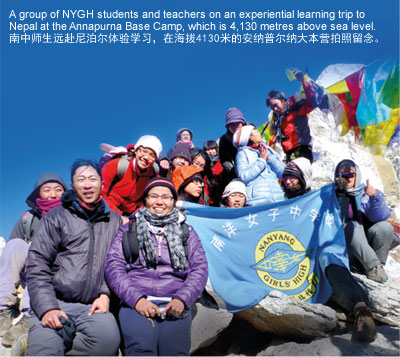 In today��s ever more interconnected world Nanyang Girl��s High School (NYGH) strongly believes in the importance of developing its students�� global competency as a key means to preserve and develop its spirit of innovation and giving �� to make a difference. It was with this in mind that NYGH created the Strategic Alliance of Global Educators (SAGE), and added another first to its distinguished list of records. In today��s ever more interconnected world Nanyang Girl��s High School (NYGH) strongly believes in the importance of developing its students�� global competency as a key means to preserve and develop its spirit of innovation and giving �� to make a difference. It was with this in mind that NYGH created the Strategic Alliance of Global Educators (SAGE), and added another first to its distinguished list of records.
Global Synergy by Education Leaders
NYGH firmly believes that the future of education lies in the collaborative efforts of global education leaders. To inculcate a culture of global interconnectedness and respect in children, school leaders must take the first step. Along with nine other founding members from China, the United Kingdom (UK), the United States (US), Australia and Singapore, NYGH set up SAGE to help meet this objective.
The other member institutions are: the Affiliated High Schools of Fudan and Peking Universities; RDFZ Xishan School and Shanghai No. 3 Girls�� High School from China; The Perse School from the UK; Menlo School from the US; Scotch College from Australia; Hwa Chong Institution and the School of Science and Technology from Singapore. The East Asian Institute is also a Conference Sharing Partner. These schools cover the whole educational landscape from public to private, and from girls to boys.
Notwithstanding their geographical differences and diverse backgrounds, all SAGE members share the same philosophy of education for the 21st century. ��It is this common ground that brings the founding members together,�� said Mdm Heng Boey Hong. ��We all share the same belief that the critical elements for 21st century education are Bilingualism and Biculturalism, 1�C1 Computing in Teaching and Learning, and Experiential Learning. The experiential learning approach is powerful because learners are engaged in meaningful authentic experiences and problem solving. Feedback received through authentic learning is immediate and uncontrived. All SAGE members also offer Chinese Language as a subject and are supportive of using technology to enhance learning.��
SAGE��s vision is summed up in the phrase: ��Leaders in education, building a better world together��. Its establishment brings together leaders in a respectful partnership and exchange of expertise.
SAGE intends to hold a biennial international conference and to publish a biennial journal. The aim of this latter is to share ideas and good practices with educators, even if they are not SAGE members. E-newsletters and the SAGE website will also form platforms for sharing ideas.
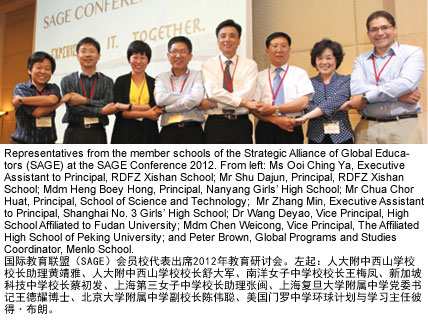 ��Educators will come together at our conferences to interact with each other and to share their thoughts on various education issues,�� elaborated Mdm Heng. ��We will also publish papers and case studies conducted by SAGE members in the biennial journal. We want to reach out to as many schools as possible from all regions. Hence, all are welcome to attend the conferences and to subscribe to our journals and newsletters.�� ��Educators will come together at our conferences to interact with each other and to share their thoughts on various education issues,�� elaborated Mdm Heng. ��We will also publish papers and case studies conducted by SAGE members in the biennial journal. We want to reach out to as many schools as possible from all regions. Hence, all are welcome to attend the conferences and to subscribe to our journals and newsletters.��
Mdm Heng also emphasised that the alliance is not a closed circle. All research and discussion outcomes of SAGE will be available to the public, especially through the e-platforms.
SAGE��s inaugural conference was held last year in Singapore and it attracted 192 representatives from 53 different institutions.
��We enjoyed a lot of interaction during the conference,�� said Mdm Heng. ��Other than the keynote speakers, all school representatives were given a ten-minute platform to share their ideas on the various issues discussed. In addition, thoughts and views on controversial topics were also raised during the session, after which all the participants gathered into smaller groups to carry out in-depth discussions on topics that were of interest to them. We also invited our guests to visit Hwa Chong Institution, the School of Science and Technology as well as NYGH, as these schools all had good practices to share.��
Mdm Heng confided in us that the setting up of SAGE was, for her, an amazing experience. Initially, she had grave doubts about the willingness of schools to collaborate and form such an alliance. But to her pleasant surprise, the formation of SAGE was a smooth and remarkable journey, with strong support coming from all its partner schools. Indeed, as proof of this the future has already been jointly mapped out with the 2014 conference to be hosted by RDFZ Xishan School in Beijing and the 2016 conference to take place in the UK in conjunction with The Perse School��s 400th anniversary.
Other than conferences for teachers, it is planned that students from the various SAGE schools will also have opportunities to participate in immersion programmes and to visit member institutions in other regions.
As an example of this, students from both The Affiliated High School of Peking University and NYGH will be visiting The Perse School later this year. ��Such diverse collaborations will make education an enjoyable journey for us all,�� said Mdm Heng.
��The establishment of an alliance like SAGE can boost the relationship among the various schools, building greater trust and opening up opportunities for in-depth discussions. It is common practice for schools, when new to each other, only to showcase their best, and solutions to critical issues in education are therefore neglected. But with the establishment of the alliance, everyone becomes more candid and we can generate more ideas through frank discussions and brainstorming. This, to me, is the greatest value of forming an alliance,�� she added.
Global Classroom Programme �� Experiential Learning for the Students
The long term goal of NYGH��s vision is ��to nurture girls who are globally attuned while strongly grounded in her history and tradition��.
A key means for achieving this is its Global Classroom Programme. ��We must allow our students to step out of their comfort zone and see the world. The very name of the Global Classroom Programme implies that enrichment and overseas immersion programmes are an extension of their learning in their own classroom and country,�� Mdm Heng shared.
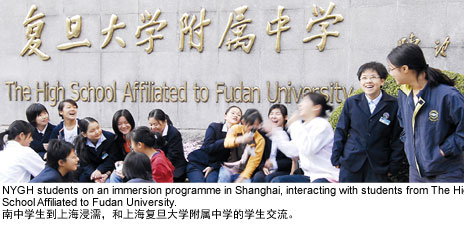 In 2011, the School incorporated elements of experiential learning into the Global Classroom Programme. ��Experiential learning provides powerful learning experiences,�� said Mdm Heng, ��because students are engaged in meaningful opportunities and real world challenges.�� In 2011, the School incorporated elements of experiential learning into the Global Classroom Programme. ��Experiential learning provides powerful learning experiences,�� said Mdm Heng, ��because students are engaged in meaningful opportunities and real world challenges.��
Mdm Heng gave us an example of what this means. ��Students are not allowed to have their usual suitcases. All clothing for the three weeks must be packed into a backpack. No transport will be arranged to pick the students up upon arrival. All students walk and take public transport on their own. The desired outcome is for students to understand that they are not there to enjoy life like a tourist but to experience the daily lives of the locals.��
The School feels strongly that opportunities such as the above must be created for the students so that they do not become detached from the real world. This is especially important because the girls�� future capacity to respond meaningfully to people��s needs will be heavily dependent upon their ability to understand real communities.
In 2011, 17 Nanyang girls embarked on a learning journey to Nanjing. Before they came home, they undertook a much needed clean-up of the school toilets. This left a deep impression on the Nanjing school as well as created a buzz in the local media. It was considered remarkable that the NYGH students could not only not walk away from a dirty toilet but felt obligated to clean it up themselves. How had the School managed to nurture such students?
��It is a process,�� explained Mdm Heng. ��NYGH has always emphasised the importance of citizenry and character education. From teaching in the classrooms to real-life applications during their immersion programmes, we motivate active learning in students through these powerful experiences. Brushes and pails are put in NYGH��s toilets. Hence, students learn the good habit of cleaning the toilets should they have dirtied them. In order to develop good habits we need to nurture the students from a young age and encourage them to apply what they have been taught in their daily lives.��
Boarding School Experience
The Boarding School Experience (BSE) was created so that the Secondary 2 cohort could benefit from a four-week stay-in programme that would allow them to experience living on their own without their parents. Many team bonding activities, including some outdoor ones on Pulau Ubin, are conducted during the month-long stay.
Moving forward, Mdm Heng would like to leverage on the boarding school facilities further to enhance the students�� experience.
��NYGH is always striving for improvement and we hope to strengthen our girls�� beliefs in core values so as to nurture them to become outstanding women. Many boarding schools in the UK have been doing very well in this area.
��Singapore is such a small island and thus most parents don��t want or need their daughters to stay in the boarding school. However, over the past two years, we have seen how our girls have developed good habits after their four-week BSE programme. They have also become more appreciative and aware of different cultures, habits and lifestyles and are more confident when they interact with people of different backgrounds. They also learn to share public space and develop a sense of responsibility when they have to live with different people. The BSE is thus a great learning opportunity for the girls,�� she said.
Enhancing Cultural Intelligence through Cross-Cultural Experiences
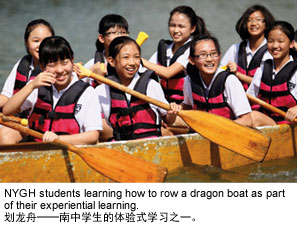 A 2012 survey of selected students in five prestigious schools, including NYGH, revealed that more than half the students didn��t have any friends from outside their own race or economic class. A 2012 survey of selected students in five prestigious schools, including NYGH, revealed that more than half the students didn��t have any friends from outside their own race or economic class.
Mdm Heng said that this is an issue that needs addressing. ��Children of the same race tend to associate in a clique. But what is even more noteworthy is that society in the future will not only be composed of the three main races �� Chinese, Malay and Indian. We will have to work with people from all parts of the world. Hence, we need to put in more effort to create platforms that encourage students to respect differences and recognise that the world is not homogeneous. At NYGH we try to guide them to embrace diversity in the world and understand different cultures. This is in addition to knowing the different ethnicities and religions.��
As part of this push NYGH has formed a Cross-Cultural Learning Committee to integrate cultural intelligence into the curriculum. As a result, a Cultural Intelligence Activity Package is now incorporated into the Global Classroom Programme so that students are able to enhance their cultural intelligence and apply what they have learnt when in another country.
Religion is also a topic discussed in school. However, this is done with the aim of deepening and broadening the understanding of the different religions and the focus is on harmony. Since 2011, NYGH has organised the Interfaith Conference together with the South East Community Development Council. During this year��s event, with its theme of Diversity in Action, representatives from different religions shared their thoughts on topics ranging from the environment to poverty from their respective religious points of view.
This year also, the School held a Face to Faith sabbatical at which eight religious leaders, representatives of the major religions in Singapore, were invited to discuss the subject of wealth and poverty and share their views from their own religious perspectives. Students were also given the opportunity to share their personal opinions with these religious leaders. The girls were therefore given a deeper understanding not only of what these religions believe but also of how they can harmoniously co-exist despite their differences. This would not have been possible without the frank and inclusive exchange that such a forum provided.
NYGH��s cross-cultural teaching and learning gained international recognition when it was nominated by the Tony Blair Faith Foundation as one of the lead schools for its Face to Faith (F2F) programme. This year the School was awarded the highest certification by the Foundation which was established by Tony Blair himself in 2008 to promote respect for and understanding of the world��s major religions, and to show how faith can be a powerful force for good in the 21st century.
In spite of NYGH��s success in this area, Mdm Heng recognised that cross-cultural teaching and learning requires prudence. ��We realised that not every student is interested in religion or willing to give it deeper thought. Hence, the Interfaith Conference was organised as one of the choices on the buffet of sabbatical courses that we provide for our students, and we make sure that their parents know what this conference entails and give their consent.��
Student Initiated Assessment
The Integrated Programme (IP) started in 2004 for NYGH. Since then, students have not been assessed solely by mid-year and end-of-year examinations. How has the School refined the assessment method for the students?
��One of the methods is to assess the students�� abilities to think, learn and do research independently,�� said Mdm Heng.
This was how the Student Initiated Assessment (SIA) came about. SIA not only reduces the weighting of examinations in overall results, it is also a form of experiential learning. Students apply the knowledge they have acquired in the classroom to their daily lives and learn to solve various real-life problems. SIA is completed within a given time frame and the mark constitutes 20 per cent of the final result.
Teachers have a set of assessment rubrics which allows students to exercise their creativity in many ways. For example, the Secondary 3 Language Arts SIA requires students to apply the functional writing skills that they have learnt to real situations in a project that allows them to contribute to society.
An example provided by Mdm Heng illustrates how such a project works. ��One group of students submitted a proposal to St Luke��s Hospital for a fundraising activity. In the process, they also wanted to create an opportunity for the School to know the Hospital better and understand its needs. This was a great challenge, so the students went through detailed discussions and conducted surveys. They found out that the common interest amongst their peers was eating ice cream and thus they thought of ways to persuade their schoolmates and teachers to buy ice cream for charity.
��Apart from promoting knowledge of St Luke��s Hospital amongst their peers, the students also discovered that when there was a common goal everyone would come together. The group therefore invited all our teachers and students to work together to achieve the target of breaking a record in the Singapore Book of Records �� i.e. having the highest number of people eating ice cream together, at the same time and place.
��The students even found an ice cream sponsor and engaged the media. On the day itself, there were over 1,200 teachers and students eating ice cream on campus. SIA was thus responsible for the teachers and students raising funds for St Luke��s Hospital by eating ice cream whilst simultaneously making it into the Singapore Book of Records. This assignment therefore not only allowed them to practise what the group had learnt in class, but also gave them opportunities to acquire very practical skills to achieve an end,�� Mdm Heng said.
1�C1 Computing in Teaching and Learning
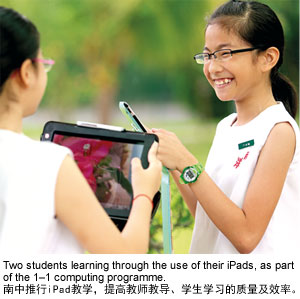 1�C1 computing in teaching and learning is almost a necessity in the 21st century. Two years ago NYGH piloted the use of the iPads in class, starting with two Secondary 1 classes and two Secondary 3 classes. Last year iPads were used across the whole Secondary 2 level and this year the practice has been expanded to include Secondary 3. 1�C1 computing in teaching and learning is almost a necessity in the 21st century. Two years ago NYGH piloted the use of the iPads in class, starting with two Secondary 1 classes and two Secondary 3 classes. Last year iPads were used across the whole Secondary 2 level and this year the practice has been expanded to include Secondary 3.
NYGH has a clear objective in its use of iPads in teaching and learning, which is not to provide a substitute for hardcopy note-taking, but to transform the learning process itself.
��Learning processes vary from individual to individual and teachers are often troubled and concerned about the different pace of students�� learning. With 1�C1 computing, teachers can record the teaching content beforehand and upload it online for the students to watch before the lesson. Students are then able to view a lecture as often as they desire and review the content. This approach allows the students to focus on clarification and discussion in class instead of just attending a lecture. Teachers can also devote more time to assisting students who are still not able to grasp the concepts in the classroom. In addition, 1�C1 computing provides students with the opportunity to carry on with unfinished classroom discussions on online platforms,�� Mdm Heng explained.
But although information and communication technology (ICT) has transformed traditional teaching methods at NYGH, Mdm Heng also stressed that the teachers�� ability to make informed decisions about its use in teaching and learning is critical. ��They need to be aware of the rationale and relevance behind ICT��s use and application so as not to waste time and effort,�� she said.
To gather information on the impact of ICT on pedagogy during the pilot phase a research assistant was engaged to observe lessons and record teachers�� and students�� questions when engaged in 1�C1 computing in class. The findings of this observation process revealed that with 1�C1 computing, teachers and students were able to gain access to information promptly and could spend more time on higher order discussions.
��We have obtained a lot of data to convince our parents. We also found in our data collection process that there are no other teaching methods that can enhance teaching and learning as distinctly as ICT,�� Mdm Heng shared.
School Middle Management��Personal Leadership Training by the Principal
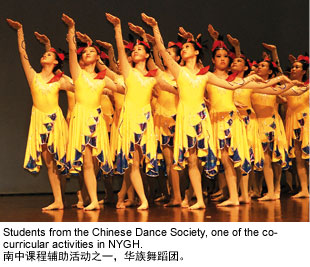 Enhancing staff competencies is also critical in NYGH. Since Mdm Heng took over the helm of NYGH in 2010 she has been personally conducting the Middle Management Leadership Development Programme. About 10 to 12 teachers or Heads of Departments are selected each year to participate in this overseas training programme led by Mdm Heng. Enhancing staff competencies is also critical in NYGH. Since Mdm Heng took over the helm of NYGH in 2010 she has been personally conducting the Middle Management Leadership Development Programme. About 10 to 12 teachers or Heads of Departments are selected each year to participate in this overseas training programme led by Mdm Heng.
��Colleagues selected for this development programme are either part of the current or future middle management of the School. We spend five days every year on this overseas training. I insist on conducting the training overseas as I believe that only by leaving the country can my colleagues�� minds be totally free from school matters, and this gives them the opportunity to do in-depth thinking and discussions without any distractions.
��During training, we embark on discussions for whole days and nights. Topics are usually drawn from the difficulties and challenges we face in school and their solutions. Before solving the problems, I also urge them to look at their own strengths, so as to guide them in understanding their leadership style and qualities better.��
In 2010 the development programme took place in Shanghai and Mdm Heng and her teachers could therefore visit the World Expo as well. In 2011, the programme was held in Bali and the team had a taste of experiential learning afterwards. In 2012, it was conducted in Ho Chi Minh City where the group went to the Asia Pacific Breweries and saw first-hand the success story of this Singaporean company in Vietnam. And in February of this year, Mdm Heng led a team of teachers to visit the Hong Kong University of Science and Technology to find out how this Asian university was able to make its mark on the world��s top university rankings in such a short period of time.
Mdm Heng is clear on why such exposure is necessary. ��I am taking my colleagues with me to broaden their horizons as I do not want them only to be looking at what is happening within the School. They should have a broader understanding of the world. NYGH has already reached a certain height. I think it is time for us to also look at what others are doing, especially leaders in different industries. We need to see how they reach greater heights.��
Looking Ahead
An alumna of NYGH herself, Mdm Heng had this to say in the School��s 95th Anniversary publication, 95 Stories of Connected Lives, ��NYGH is like a towering tree, always there to protect and provide shade for us. Today, I have the honour to return to my alma mater to serve and pass on the Nanyang spirit and rich heritage.��
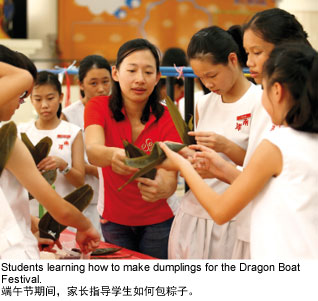 SAGE, cross-cultural learning, overseas experiential learning, the use of 1�C1 computing in teaching and learning and the introduction of student initiated assessment are some of the ways by which she is doing this. SAGE, cross-cultural learning, overseas experiential learning, the use of 1�C1 computing in teaching and learning and the introduction of student initiated assessment are some of the ways by which she is doing this.
And when we asked Mdm Heng to sum up her vision for NYGH��s future she was in no doubt. ��We need to have our eyes on the world, to seize opportunities and take up challenges along the way. Not only does NYGH need to strive towards being a world-class school, we also need to assume the role of a leader in education.��
Translated by: Lee Xiao Wen
|